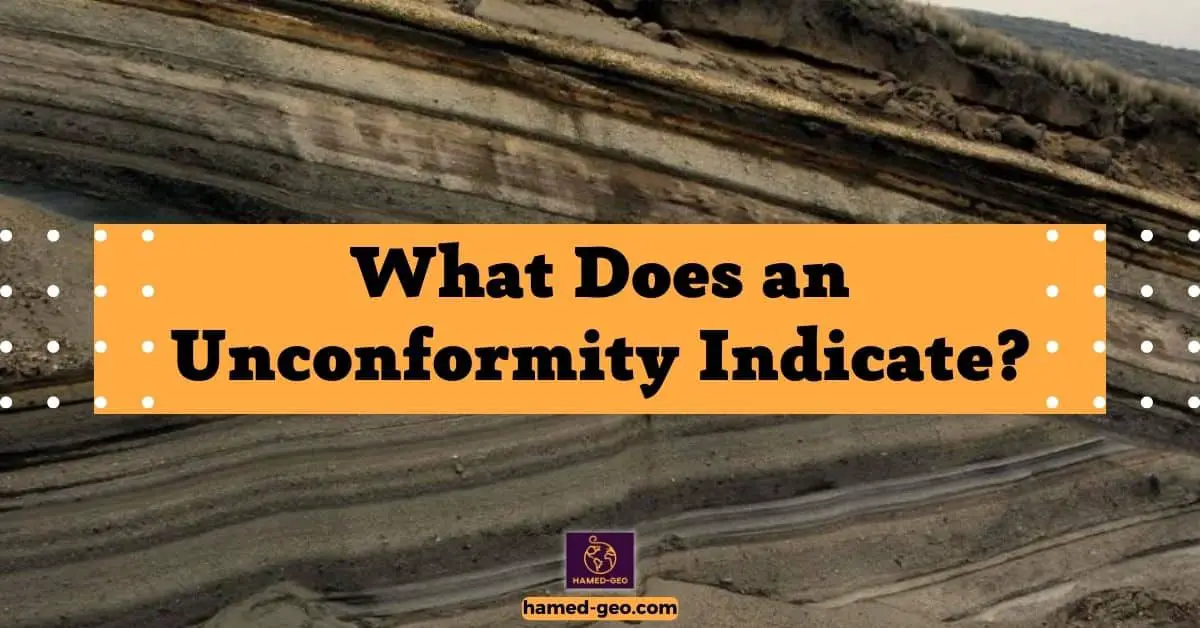Unconformities are geological features that represent gaps in the rock record. They occur when there is a period of erosion or non-deposition, followed by the deposition of new layers of sediment. Unconformities are important markers in the geologic record as they provide evidence of significant events and changes in Earth’s history.
One interpretation of an unconformity is that it indicates a period of time missing from the rock record. This missing time could be the result of erosion, where layers of rock were removed from the surface and completely lost. Alternatively, it could be due to non-deposition, where no new sediment was being added to the area during that time. In either case, the presence of an unconformity suggests that there was a break in the sedimentary sequence and that some geological processes occurred during that time. These processes could range from tectonic events, such as uplift and erosion, to changes in sea level or climate. By studying the types and characteristics of unconformities, geologists can gain insights into the geological history of an area and the processes that shaped it.
What an Unconformity Indicates
An unconformity, which is a gap in the rock record, can indicate several important aspects of the Earth’s history:
- Changes in the environment can be inferred from the types of rocks or fossils that are present before and after the unconformity.
- The geological history of a region can also be deciphered by studying the unconformity, as it provides clues about the sequence of events that occurred in the area.
- Additionally, the presence of an unconformity suggests disruption or erosion of rock layers, indicating that significant geological processes, such as tectonic activity or weathering, have occurred.
Changes in the Environment
Changes in the environment can occur due to various factors such as:
- Tectonic activity
- Sea level changes
- Climate variations.
These changes can lead to the formation of unconformities as the existing rock layers are exposed to erosion or are covered by new sediment. For example, a rise in sea level can cause the deposition of marine sediments on top of previously exposed land, creating a new layer that unconformably overlies the older rock layers.
Unconformities can also indicate significant shifts in the environment. For instance, the presence of a nonconformity, which is an unconformity between igneous or metamorphic rocks and overlying sedimentary rocks, suggests a transition from a period of volcanic or tectonic activity to a period of sedimentation. This change in the environment can be indicative of the evolution of a region from a volcanic or mountainous terrain to a more stable and sedimentary environment. By examining the characteristics of unconformity, geologists can gain insights into past environmental conditions and the processes that shaped the geological history of a particular region.
Geological History of a Region
Understanding the geological history of a region is crucial in interpreting the significance of an unconformity. Unconformities are surfaces that represent gaps in the geological record, indicating periods of disruption or erosion of rock layers. By examining the changes in the environment that occurred during these periods, geologists can gain valuable insights into the past processes that shaped the region.
One way to determine the geological history of a region is through the study of sedimentary rocks. These rocks are formed from the accumulation of sediments over time, which can provide a wealth of information about past environmental conditions. For example, the presence of marine fossils within a sedimentary sequence suggests that the region was once covered by a shallow sea. On the other hand, the absence of marine fossils and the presence of terrestrial plant remains may indicate a period of land-based deposition.
By piecing together the evidence from various rock types and their associated geological features, geologists can reconstruct the geological history of a region. This knowledge is essential for interpreting the significance of an unconformity, as it allows them to determine the nature and duration of the processes that led to the erosion or disruption of rock layers. Ultimately, understanding the geological history of a region provides valuable insights into the dynamic nature of Earth’s processes and the long-term changes that have shaped our planet.
Disruption or Erosion of Rock Layers
Disruption or erosion of rock layers is a key indicator of an unconformity in the geological record. Unconformities represent gaps in the rock record where layers of sedimentary rock are missing, indicating a period of erosion or non-deposition. These disruptions can occur due to various environmental factors and processes, providing valuable insights into the changes that have taken place in the Earth’s history.
One common cause of disruption or erosion of rock layers is the changes in the environment. Over time, the Earth’s climate and landscape can undergo significant transformations, leading to the erosion of existing rock layers. For example, the uplift of a mountain range can expose previously buried rock layers to erosion by wind, water, or ice, leading to the removal of the upper layers and the formation of an unconformity. Similarly, changes in sea level can result in the erosion of coastal rock layers as they are exposed to wave action and tidal forces. These changes in the environment can leave behind distinct geological signatures, allowing scientists to reconstruct the geological history of a region.
The geological history of a region can also contribute to the disruption or erosion of rock layers. Over millions of years, various geological processes such as tectonic activity, volcanic eruptions, and the formation of sedimentary basins can alter the landscape and lead to the removal or deposition of rock layers. For instance, a period of intense volcanic activity can cover existing rock layers with layers of volcanic ash, obscuring the geological record and creating an unconformity. Similarly, the formation of a sedimentary basin can result in the accumulation of sedimentary rocks, burying and eroding older rock layers in the process. By studying these geological events and their impact on the rock record, scientists can gain a deeper understanding of the geological history of a region and the processes that have shaped it over time.
What Is an Unconformity?
An unconformity in geology refers to a structural discontinuity in the rock record that represents a significant period of erosion or non-deposition. It occurs when there is a gap in time between the deposition of one layer of rock and the subsequent layer. Unconformities are crucial elements in deciphering the Earth’s history as they provide evidence of past geological events and the dynamic nature of the planet’s surface.
Unconformities can be recognized by the differences in rock types, ages, or orientations between adjoining layers. They serve as markers of missing geological time, indicating periods when erosion processes actively weathered and removed existing rock layers before new sediment was deposited. Consequently, unconformities play a vital role in reconstructing the geological history of an area, allowing scientists to understand the complex processes that have shaped the Earth over millions of years.
Types of Unconformities
Unconformitiesb can be classified into three main types: angular unconformities, nonconformities, and disconformities. Each type represents a distinct geological phenomenon and provides valuable insights into the Earth’s history.
Angular unconformities

Occur when there is a significant angular discordance between the underlying rock layers and the overlying ones. This type of unconformity is commonly observed in areas where there has been a period of tectonic activity, such as mountain building or folding. As a result of these forces, the older rock layers are tilted or folded, and then eroded before the deposition of younger sedimentary layers. The resulting contact between the two sets of rock layers is marked by a clear angular discordance, creating a distinct angular unconformity.
Nonconformities
On the other hand, nonconformities characterized by a contact between older igneous or metamorphic rocks and younger sedimentary layers. This type of unconformity indicates a significant change in the geological environment. For example, a nonconformity may be formed when an ancient mountain range is eroded and the resulting sediments are subsequently deposited on top of the eroded rocks. The contact between the different rock types is often sharp and can clearly be seen in the field.
Disconformities
Disconformities are unconformities where the contact between two sets of sedimentary layers is parallel or nearly parallel. In other words, there is no significant angular discordance or change in rock type. Disconformities are often more difficult to recognize, as they may appear as continuous layers of sedimentary rock. However, careful examination of the rock layers and their ages can reveal gaps in the deposition, indicating a period of erosion or non-deposition. Disconformities can occur due to various factors, such as changes in sea level, climate, or sediment supply.
Understanding the different types of unconformities is crucial for reconstructing the geological history of an area. By identifying and studying these gaps in the rock record, scientists can gain valuable insights into the processes that have shaped our planet over millions of years.
In conclusion, an unconformity is a significant geological feature that provides valuable information about the Earth’s history and the processes that have shaped its surface over time. It indicates a period of missing or lost rock layers, suggesting that there was a disruption in the deposition, erosion, or deformation of sedimentary rocks. Unconformities can be categorized into three main types: angular unconformities, nonconformities, and disconformities, each representing different geological events. These features are formed through various processes, such as tectonic activity, erosion, and sedimentation, which can be identified and analyzed by geologists.
Geologists utilize unconformities as key tools in reconstructing the geological history of an area. By examining the different types of unconformities and their characteristics, geologists can determine the timing and nature of past geological events, such as mountain building, erosion, and sea-level changes. Unconformities also provide significant insights into the evolution of the Earth’s surface and the processes that have shaped it. They can help identify the presence of ancient landscapes, ancient climate conditions, and the occurrence of major geological events, such as mass extinctions.
Overall, unconformities play a crucial role in understanding the Earth’s geological history. Their presence indicates gaps in the rock record, allowing geologists to piece together the puzzle of the Earth’s past. By studying these features, geologists can gain valuable insights into the processes that have shaped our planet and make predictions about future geological events. Through continued research and analysis, the study of unconformities will undoubtedly contribute to our understanding of the Earth’s complex history and the forces that continue to shape it.




[…] sequence can be thought of as a distinct episode of sediment deposition that is bounded by unconformities or sequence boundaries that represent significant changes in sea […]